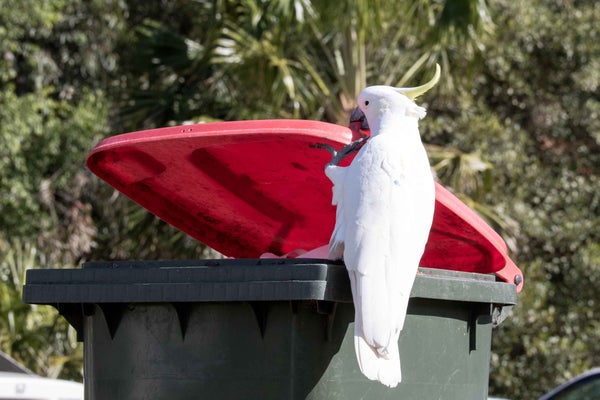Sometime in the 2010s a Sulphur-crested Cockatoo living in a sleepy suburb of Sydney, Australia, had a breakthrough. This bird, likely a large, dominant male, somehow figured out how to use its powerful beak to grip, pry and flip open the lids of garbage bins to look for food inside. The innovation soon sparked a trend that spread throughout the cockatoo population. Other birds from different suburbs devised their own styles of bin opening, which spread to become local subcultures: Cockatoos from different areas open bins in distinct ways. One neighborhood’s birds might use their beak to grip a bin’s handle, for instance, whereas another’s use their beak with one of their feet to grip the rim of its lid. Now new research illustrates how—by raiding garbage bins and trashing Sydney-area streets in the process—the cockatoos may have started an arms race with humans desperate to keep their neighborhoods clean.
Cockatoos are a type of parrot, and like crows, they are known to have a formidable bird brain. “[Parrots] are pretty cognitively flexible in terms of their problem-solving,” says Elizabeth Hobson, a behavioral ecologist at the University of Cincinnati, who was not involved in the new study. “They can learn from others, and they can innovate.”
This learning ability was highlighted in a 2021 paper that first documented the cockatoos opening bins in the suburbs of Sydney and nearby Wollongong, Australia. “We described [the behavior] in detail,” says Barbara Klump, a behavioral ecologist at the Max Planck Institute of Animal Behavior in Germany and lead author of both studies. With the new study, published today in Current Biology, Klump and her colleagues decided to focus on the human side of the story after witnessing residents trying to protect their bins. “I was amazed by how many different methods of protection there were,” she says.
On supporting science journalism
If you're enjoying this article, consider supporting our award-winning journalism by subscribing. By purchasing a subscription you are helping to ensure the future of impactful stories about the discoveries and ideas shaping our world today.
The researchers ranked these methods by how much they involved altering the bin itself: A low-effort solution, such as a rubber snake on top, was given a rank of 2, whereas a heavy rock was classified as 3. And a high-effort, high-investment method, such as an attached weight, received a rank of 5. Klump and her team then mapped out the garbage bins and statistically analyzed their spatial network to show that, like the cockatoos, humans living closer together tended to share similar strategies. This result was backed up by resident surveys from 2019 and 2020, where 60 percent of the majority of respondents who picked up their method socially did so from neighbors. Despite the potential to seek help from across Australia or even the world, thanks to the Internet, the Sydneysiders seemed to primarily look locally for solutions. “It’s really interesting that [the researchers] are seeing that,” Hobson says. It suggests the residents may be picking up defensive strategies passively rather than actively seeking help, she adds.
Video Credit: Barbara Klump/Current Biology (CC BY-SA 4.0)
The new study also provides evidence of a potential “innovation arms race” between humans and the cockatoos, in which a behavioral change in one of the species leads to a new, socially learned response by the other, which itself prompts a response, and so on. The most common reason for changing a protection method that residents reported on the survey was that the cockatoos had worked out how to defeat their original strategy—for example, one cockatoo was caught on video nudging a brick off the top of a bin before confidently opening it, which the bird had presumably done many times before. Scientists have suspected for some time that such interspecies innovation arms races existed, but no one had really looked for one before, the researchers say. “I think [this study] is the first time that anyone has laid out what they would expect if [an innovation arms race] is occurring and tried to show it,” says Lucy Aplin, a behavioral ecologist at the Max Planck Institute for Animal Behavior and senior author of both studies. “We have indirect evidence that there’s an innovation arms race happening.”
To confirm an arms race raging in Greater Sydney, the researchers will need to go back to the birds. Now that they know cockatoos can defeat at least one human defense, they need a bird’s-eye view of an escalating back and forth. “We need to do more work to show how the birds are learning to defeat those measures,” Aplin says, “and whether they can also continue to respond ... as the humans increase the effectiveness” of their own strategies. Luckily, the Sydney-area community will likely welcome further work on this feathery face-off. “Everyone has an opinion on [the cockatoos],” Klump says. “The survey is actually running again this year, I think it's now the fourth year, and I'm always amazed how willing people are to still fill it in. I’m super grateful.”
Though these cockatoos’ charisma is undeniable, their clever behavior causes real harm: it costs time and money to clean trash from the streets, and it’s understandably annoying to have personal waste scattered around for all to see. In addition to testing for an innovation arms race and demonstrating how dynamic animal cultures can be, the research also has implications for how humans coexist with their animal neighbors. “This study is an illustration of how we need to consider animal behavior,” Aplin says. “If we respond to these nuisance behaviors, then we need to think carefully about how we respond.”
It’s an open question whether the human-cockatoo conflict will ever end, but for now, the struggle has one clear winner: science.
